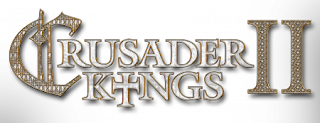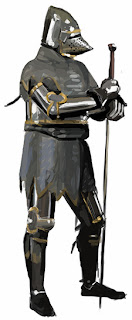I know of a few games that include many features that I find most ideal, but the way it approaches some of these is not exactly how I would like them to be. One of these games is Crusader Kings II. Crusader Kings II heavily explores the medieval feudal structure and dynastic dynamics. These two core features already drove me to love the game. However, there are certain ways I dislike about the game, such as how warfare is handled and a lack of jure uxoris.
Recently I've been playing a game called War of the Vikings, a Third-Person Slasher which involves a lot of heavy melee combat. Players go online and are pitted against other players, like an MMORPG, only it plays more like conventional First-Person Shooters, such as the lack of emphasis of a level progression system and more on personal skill. The game is currently in its Early Access phase and should include player customization, which allows you to alter equipment and personal perks, almost like RPGs. However, there are some things I disagree with, such as the general animation where actual combat looks clunky when you're viewing it as a spectator.
Back when I played MMORPGs, I use to play this game called Vindictus. It was a heavy action based game that too relied on personal skill, more than character stats and properties. Another thing I liked about the game is this particular "loadout" system, where before you enter a dungeon, you must be sure to organize what sort of limited equipment you are taking in, because you will not be able to pull random equipment like in most RPGs. However, the game was highly restrictive in terms of character customization, classes were restricted to certain genders and races, and I was never a fan of Baroque-esque fashion.
To be honest, I know there are limitations to the practical side of game development. I understand that I cannot smash everything I like into one game, such as taking the property, title, and dynastic management from Crusader Kings II, yet including a free roaming experience where you can conduct melee combat like that in War of the Vikings and Vindictus. That is too crazy and has too many features. I'd rather stick to one concept and build upon that.
The current game I am developing is a pen & paper RPG. MDA Framework states that developers tend to develop games by starting with the mechanics, while players are drawn into games by their aesthetics. When I sat down to brainstorm a game project, I only listed aesthetics, certain features or attitudes I would like to see in the game. And from that route, I go down to dynamics and then mechanics.
I started with aesthetics simply because, as a player, I look for games that appeal to me. So first I am thinking about what sort of appeals do I want from this game? I wanted intense, tactical combat, character customization, and a way to portray the game like a "shounen" genre (shounen is a common genre in Japanese anime and manga that usually deals with action and other elements). There are plenty of games out there that already deal with tactical combat and character customization. It is the shounen aesthetic that I think will make it original, but even then I like to approach different ways the intense, tactical combat can be rendered.
After understanding the aesthetics I wanted, I made a list of features within the game, those are the dynamics. I believed starting with the combat aspect was vital, since character statistics will derive from that, and hence character customization. I needed numbers that can portray a character, and what sort of combat statistics will be used. At first I played around with the idea of Mutants & Masterminds, which doesn't use the conventional hit-points system. Instead, when a character is damaged, that character must roll to protect himself from harm. Failing to do so will result in consequences or incapacitation. Sometimes the character will roll high enough to suffer no consequences, but whenever a consequences is earned, a penalty to further rolls to protect oneself is added. Then I thought that was too complicated for the average player, maybe. I rather liked the conventional hit-points system anyway, so I stuck with that.
One thing that I utterly hated in Dungeons & Dragons is the union of a character's ability to dodge attacks and resist damage. I always preferred a separation of the two. This also, to an extent, means that a character's ability to hit a target and to damage are also combined. Personally, I always thought it was stupid. So I created the four basic offensive and defensive combat statistics for characters: Attack which measures how well a character can land a hit on a target, Damage which measures how much HP is deducted from the target if the character is hit. For the defensive statistics, there are Defense which measures how well a character can avoid being hit, and Protection which measures how much damage is reduced.
Then I moved down to how these statistics are actually resolved. This is the core mechanic. I'm actually proud with what I came up with, I found it to work solidly after many tests. But first I started with three six-sided dice. You roll the dice and added up the results, and add your attack or defense to the result. After many iterations and inspiration from a certain online game called Card Hunter, I began using the d6 pool system. In the pool system, you roll one d6 for every point you have in an ability, and every die that rolls 4 or higher counts as a success. As I refined the pool system, I found that it was hard to find a way to not crowd the table with dice. However, after doing a little bit of research, I discovered that a certain game, that I never played but am familiar with called Shadowrun, uses plenty of dice on the table. I then thought it shouldn't be a problem so I stuck with the dice pool system.
I came up with different features the tactical combat can have, such as how flanking works, combat stances that gives you certain advantages and disadvantages, deciding on whether to use a grid, hexgrid, or no grid, etc. Even equipment will have properties, such as blunt, cutting, and crushing damage, which all should have different results when damaging a character. I wanted all of these features to force players to think about participating in combat, but at the same time I know I don't want too many features that make the game overcomplicated. I don't even see this as a compromise, because my ideal and perfect game shouldn't be overcomplicated.
After understanding the different features and statistics involved in combat, I felt I was comfortable with creating a template for character creation, and what sort of vital statistics were important for characters. But how those statistics were derived was the question. Most games have characters that have something called base abilities. Base abilities represents the core stats of characters that are involved in everything a character does. I knew I wanted the base abilities to represent the basic bodily abilities of a character, such as their physical strengths and mental natures. If there was one thing I hated from Dungeons & Dragons, it was the ability dexterity. I hated dexterity because it covered almost everything: Manual coordination, physical agility, and general skill for anything that involves using your body or hands. Instead I decided to have dexterity be more of a "skill", which I will get into later.
Early on, I settled on a trend number. This number will go on to be embedded in the rest of the game mechanics. I did this because I was sort of tailoring this game to fit a certain fantasy world I created for another game that I am still currently running. That number is 6. Six-sided dice, six-sided hex grids. And so I wanted 6 base abilities. Those abilities would be: Might, Vitality, Learning, Cunning, Attunement, and Resolve. 2 physical abilities, 2 mental abilities, and 2 abilities that practically represent the temperament of the character. All 6 of these abilities are, ideally, things that are not learned by naturally developed.
There are other features I'd like to talk about, but I want to go over the shounen mechanics. I had to do a little research on the common trends of shounen stories. One thing I noticed is the sliding scale of optimism and cynicism. Heroes tend to be over optimistic, always sticking to their beliefs, and believing that fighting for what you believe them will grant you victory. But heroes also want to be known, to be famous, to be the best there ever is, hence why they train a lot. I borrowed a mechanic from Crusader Kings II, a mechanic which measures a characters piety and prestige. A character's piety will represent how well a character sticks to his believes, and they can use points of piety to enhance their rolls. A character's prestige represents how famous they are, and they can use points to influence other characters. I believe this one mechanic is the best way to represent the shounen genre. It's more of a little element, which doesn't make the game anymore shounen than it is not however.
That's all I have to share about my current progress. I can go into more detail about what I have and how things worked, but this post was only meant to describe my thought process and why certain features were added, not explain how they work.






































